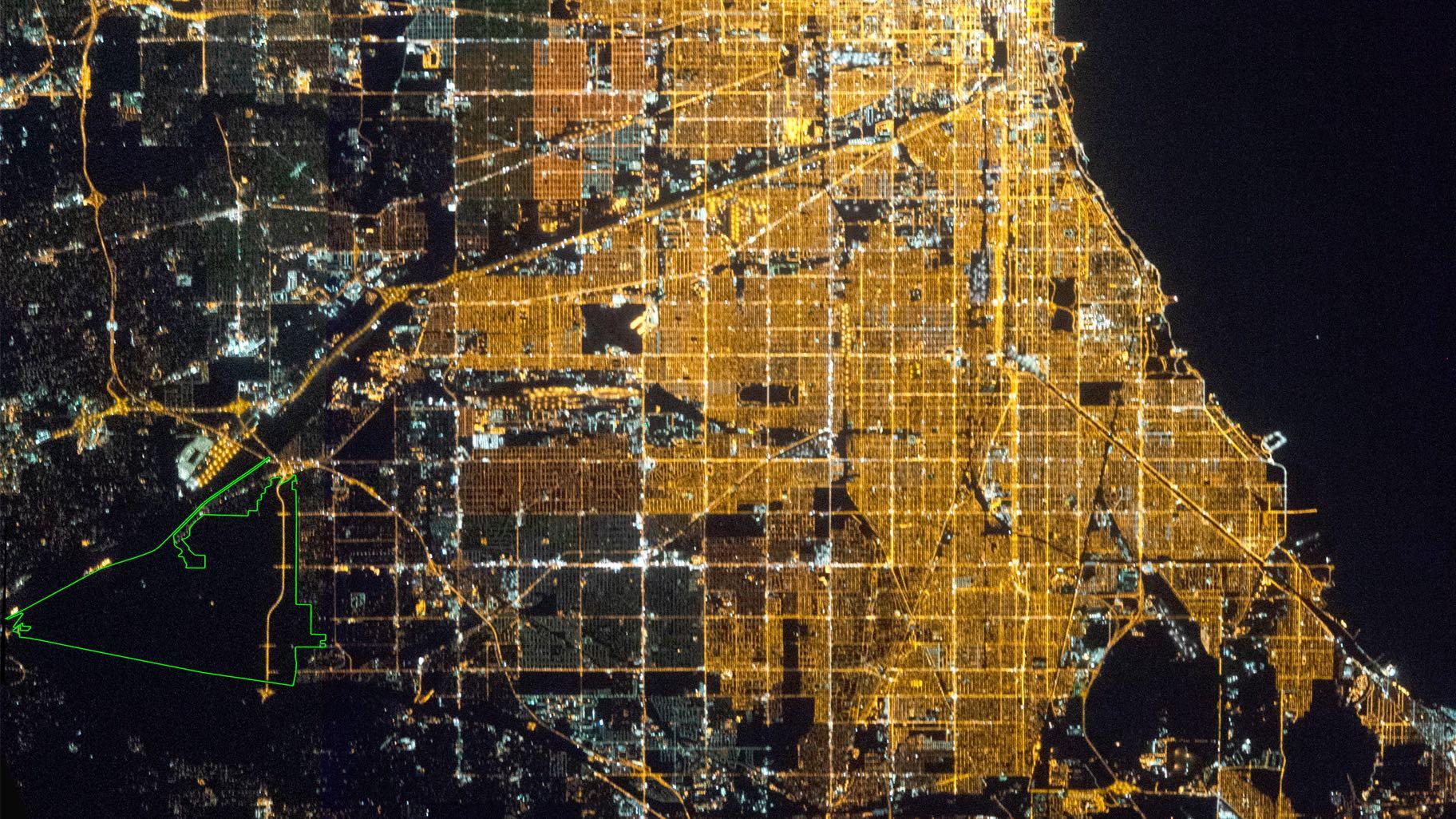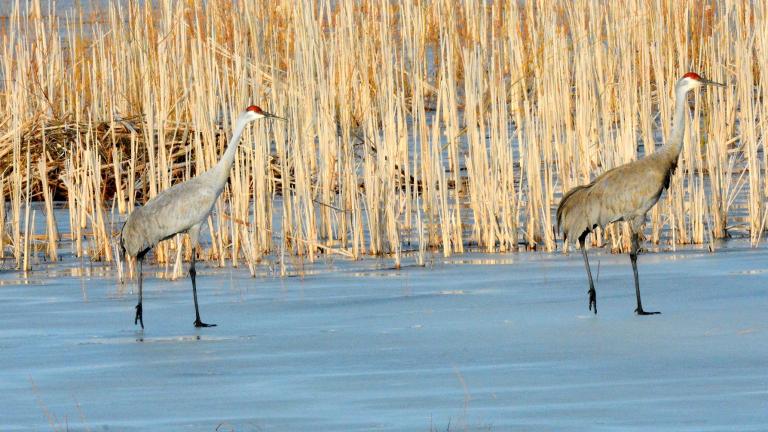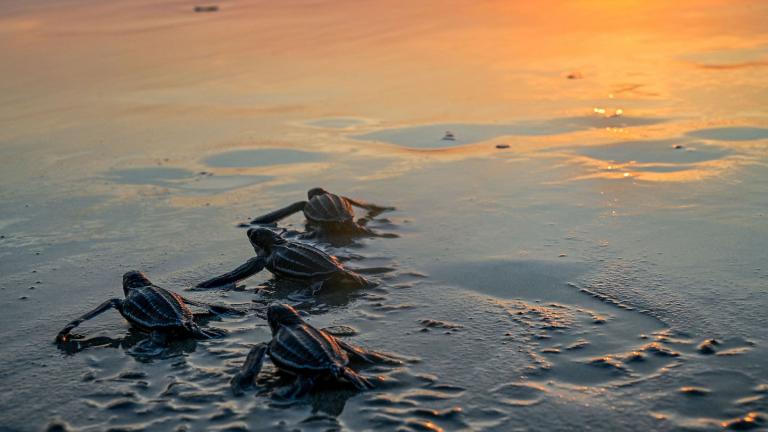The expansive Palos Preserves in southwest Cook County, encompassing sites such as Pulaski Woods and Saganashkee Slough, is known for its hiking and biking trails, including rare (for Chicago) hills. But among the preserves’ most impressive features is one that can only be appreciated after sunset, when the gates close.
It’s dark.
Not just noticeably dark, but measurably so, as quantified by a team from the Adler Planetarium. And now the preserves can claim to be certified dark, thanks to a just-announced designation as an Urban Night Sky Place by the International Dark-Sky Association.
 Chicago as seen from the International Space Station. The Palos Preserves Urban Night Sky Place is outlined in green. (Courtesy of the Earth Science and Remote Sensing Unit, NASA Johnson Space Center)
Chicago as seen from the International Space Station. The Palos Preserves Urban Night Sky Place is outlined in green. (Courtesy of the Earth Science and Remote Sensing Unit, NASA Johnson Space Center)
The association, which promotes the conservation of dark skies and advocates against light pollution, defines an Urban Night Sky Place as a property that promotes an “authentic nighttime experience in the midst of significant artificial light.” There are only two besides Palos in the world: one is in Utah and the other in New Mexico.
As part of the process of applying for the designation, the Forest Preserves of Cook County partnered with the Adler Planetarium on a plan for light reduction at the preserves’ buildings and parking lots. Teens participating in the Adler’s Far Horizons Stratonauts program also helped measure and document the light levels in Palos Preserves, as well as the broader region, by making use of satellite imagery and data provided by the International Space Station.
Their findings showed that Palos Preserves emits nearly 1,000 times less light than downtown Chicago, with four times as many stars visible in the night sky than can be seen in the city.
“People know the Palos Preserves for its extensive trail system and the natural wonder of the hills, bluffs, woodlands and wetlands. I’m pleased that with this Urban Night Sky designation, the site is also recognized as a location that preserves the night,” Arnold Randall, the general superintendent of the forest preserves, said in a statement.
The forest preserves laid out a dark sky-friendly policy in fall 2020 as part of a push to reach net zero greenhouse gas emissions. The goal is to transition all indoor and outdoor lighting within five years to meet International Dark-Sky Association recommendations, such as the use of programmable and dimmable lights.
Pursuing the Urban Night Sky Place designation was about much more than achieving energy efficiency, though, according to Stacina Stagner, a spokesperson for the forest preserves.
“We know artificial lighting can lead to many problems for birds, including reduced growth rates and failure of bird chicks, confusion and crashes for migrating birds, and interruption of nighttime mating rituals,” she said. “Studies also show the attraction of insects to light is intense, disrupting their normal feeding and mating behavior. Lights are also known to disrupt frog mating and severely impact bat feeding behavior.”
Protecting wildlife is explicit in the forest preserves’ dark sky policy: “The district is home to rare and endangered ecosystems and related wildlife species. Bad lighting practices have lethal consequences for wildlife, but the implementation of this policy can help restore healthy urban ecosystems.”
Too much light is bad for humans, as well. It’s linked to increasing risks for obesity, depression, sleep disorders, diabetes, breast cancer and more.
But when it comes to dark skies, urban dwellers almost don’t know what they’re missing, having grown accustomed to the bright lights of big cities like Chicago, said Ken Walczak, senior manager for Far Horizons at the Adler Planetarium.
“For the entire history of life on Earth, dark nights followed sunlit days. In a little more than a century, we’ve altered that natural pattern by illuminating our nights,” he said in a statement. “The chance of experiencing a natural, dark night — as it was for eons — is now too rare. It’s difficult to express the peaceful, natural beauty one can experience within the Palos Preserves’ pristine nights. This designation is a recognition of the value it offers to everyone in the region.”
The catch is that Palos Preserves, like all forest preserves in Cook County, closes at sunset, so those pristine nights typically are off-limits to humans.
One way to enjoy the newly certified dark skies is to go full immersion and plan an overnight outing at Camp Bullfrog Lake, which can accommodate tents and RVs and even has cabins to rent.
The forest preserves and Adler Planetarium said they plan to continue their partnership in the Palos Preserves, creating events like stargazing nights, night hikes, owl-watching and light pollution awareness programs.
Contact Patty Wetli: @pattywetli | (773) 509-5623 | [email protected]
Note: This story was originally published Aug. 25, 2021. It has been updated.








